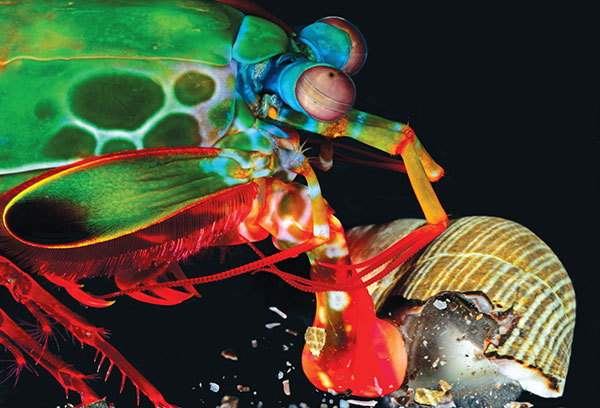
This Article From Issue
November-December 2015
Volume 103, Number 6
Page 372
DOI: 10.1511/2015.117.372
To the Editors:
I have three comments regarding S. N. Patek’s article “The Most Powerful Movements in Biology” (September–October):
The first is amazement that the mantis shrimp achieves such speed in water, a medium remarkably unyielding to rapid movements. The damage a car receives if it hits the water at 60 miles per hour (the speed so rapidly reached by the smashing mantis shrimp’s “hammer”) implies some of the energy is dissipated in the creation of a pressure wave. Could the energy of the strike be parceled into (1) energy creating a pressure wave, (2) energy moving water out of the way, and (3) impact of the “hammer” on the shell?

Photograph courtesy of Roy Caldwell.
The second comment involves cavitation amplification of the power. The presence of cavitation suggests that the retraction of the “hammer” is also remarkably rapid. In addition, the amplification should come via two mechanisms: The first, the concentration of energy into a smaller time interval, was addressed in the article and measured by the sensor. The other is a spatial concentration due to the very small size of the collapsed cavitation bubble. Since the inrushing water is coming from every direction except the shell, the final collapse should be on or very near the shell surface, so the energy reaching the shell should not be spread out. Would the additional concentration of power by this second mechanism (meaning the energy hitting the smaller area of the shell from the collapsed bubble compared to the size of the area that would be hit by the “hammer” impact) have any effect on the sensor? If not, the gain in destructive power using cavitation is even higher than the sensor indicates.
Finally, could another powerful biological movement example be a human snapping someone with a towel?
Jack Rickly
Dumont, NJ
Dr. Patek responds:
To answer the first set of questions, there are a number of hydrodynamic phenomena that are likely to play a role in energy dissipation during the strike. The three that Mr. Rickly lists are excellent ideas. One of our goals in the coming years is to look more closely at the fluid dynamics of the strike so that we can get a better understanding of how the mantis shrimp moves the water during the strike and how the water flows around the appendage.
With regard to the second set of questions: The hammer bounces off its target such that one mechanism for cavitation generation is through negative pressure between the recoiling appendage and the target. Cavitation also forms as a sheet that spreads over the surface of the target. We see cavitation in a variety of forms during the strike, which is not surprising, given the variable nature of such processes.
Both the spatial and temporal dynamics of cavitation are important to its extreme energy output. Indeed, the rapid collapse is a superlative example of power amplification. And, analogous to the incredible pressure at the tip of the microscopic stinging spears of jellyfish (nematocysts), the concentration of energy release into a small area can dramatically increase pressure.
Our mechanism for measuring cavitation in mantis shrimp isn’t ideal—we’re just using a force sensor. To more accurately measure the energetics of the strike and cavitation, we should measure pressure and that requires a spatial component to the measurements. That’s a challenge—one that we are hoping to tackle in the coming years.
Lastly: One of the fun things about studying power amplification is the realization that it is all around us. We humans do many behaviors and build many devices that transform the mediocre power output of our muscles and enhance the rate of work production to get better power output. Snapping towels is a great example. Thanks to Mr. Rickly for these insightful questions. We still have a lot to learn.
American Scientist Comments and Discussion
To discuss our articles or comment on them, please share them and tag American Scientist on social media platforms. Here are links to our profiles on Twitter, Facebook, and LinkedIn.
If we re-share your post, we will moderate comments/discussion following our comments policy.